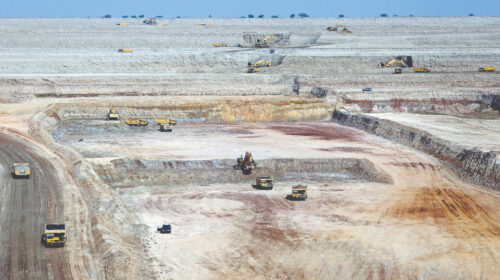THAR: Pakistan has witnessed a mushroom growth of electricity generating facilities in the last decade, but inefficient power evacuation networks, over-generation capacity and overloaded transmission systems are forcing the producers to downsize their planned expansions.
The Sindh Engro Coal Mining Company (SECMC) is among those major players, which has slashed its initial plan of installing 5,280MW power generation plants in Thar Block-II by 50 per cent to 2,640MW.
The company is the operator of a coal mine in Thar Block-II and the mine-mouth power plants. It has already commissioned 2x330MW units in July 2019, while another 2x330MW plants are set to commence operations by the end of the current fiscal year.
SECMC Director Technical Ahmed Muneeb said that the company is evaluating options regarding establishing 5,280MW plants.
“We are evaluating our options, and maybe we won’t go with our initial plan to establish 5,280MW plants but yes, the mine will be expanded to a production capacity of 15 million tonnes/annum,” he said.
“There will be massive over-generation capacity in the country soon, while the transmission and distribution systems are not ready to evacuate such a quantum of power,” he said.
“The country’s transmission and distribution systems are quite fragile and there have been no considerable investments in this sector,” he added.
According to the National Electric Power Regulatory Authority (Nepra), the national grid was developed not only for system reliability but also to provide a nationwide transmission network capable of evacuating power from the electric power generation plants located anywhere in Pakistan and transmit it to load centres across the country.
“The existing transmission network, at various occasions, proved incapable to do so,” he said.

With the advancement of renewable technologies and promotion of distributed generation, as well as improvement in the gas transmission system, it is now high time to evaluate and plan for the need of regional grids and micro and mini grids, besides the national grid.
As a matter of fact, still millions of people in the country do not have access to electricity. Through development of micro and mini grids, the electricity could be provided to those areas of the country where people are still living without this basic necessity.
The recent pandemic has created a global supply chain crisis, which has contributed to the increasing international commodity prices. Hence, Pakistan’s reliance on indigenous resources can create a safety buffer for the country in terms of affordability, as well as reliability.
SECMC has already achieved a production landmark of 10 million tonnes of coal, which effectively saved over $200 million of foreign exchange, which the country would have spent on importing the commodity, if it wasn’t for Thar Block-II.
With the planned expansion, Thar coal will become a game changer by creating a positive impact for the country’s economy with enough potential for fueling growth not just in the energy sector but other industries, as well.
Thar coal can also be converted to gas and liquid conversion in the future that can prove to be vital for power generation and other industries such as cement, steel, and the fertiliser industry.
Coal plays a substantial role in power generation, but it is also an important ingredient to be utilised as a key raw material to manufacture cement, which fuels infrastructural development for Pakistan.
“We will keep expanding the mine to the optimum level, and we are already in discussion with certain business houses for conversion of coal into diesel, as well as generating synthetic gas, which can be used in the fertiliser manufacturing,” Muneeb added.
“Exporting coal is also an option under consideration. Given the logistics ease, the commodity can also be exported to India, which is running 8,000MW of coal power plants. These Indian plants use the same lignite coal as being produced in Thar. Nonetheless, coal exports to India are solely dependent on the country’s foreign policy.”
Pakistan and India have restricted all trade with each other, with the exception of certain pharmaceutical products being imported in Pakistan.
SECMC is one of the two main lignite coal mining operators in the country. It is a joint venture between the government of Sindh, Engro Energy Limited (formerly Engro Powergen Limited) and its partners; Thal Ltd (House of Habib), Habib Bank Ltd (HBL), Hub Power Company (Hubco), and China Machinery Engineering Corporation (CMEC).
The world-class Huolinhe Open Pit Coal Mine in Inner Mongolia, China, a subsidiary of China’s State Power Investment Corporation, has also joined the SECMC board as strategic investor with preference shares’ subscription.
The other main mine in the country, which is just going into production is operated by Sino Sindh Resources Ltd (SSRL), which is located in Block-I of the same Thar region; it is also a China-Pakistan Economic Corridor (CPEC) project and is owned by the Chinese group, Shanghai Electric Power Company Ltd.
It comprises a 7.8 million tonnes/annum open-pit coal mine and a 1,320MW coal-fired power plant. Mining work was set to be completed by the end of 2021 and the first unit of the power plant is due to start working from 2022, while the entire project is scheduled to be completed by 2023.






